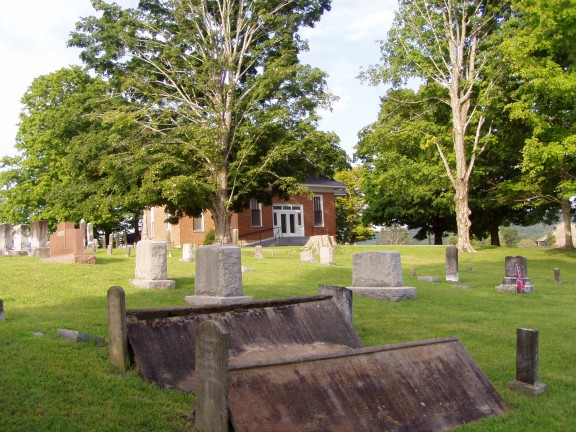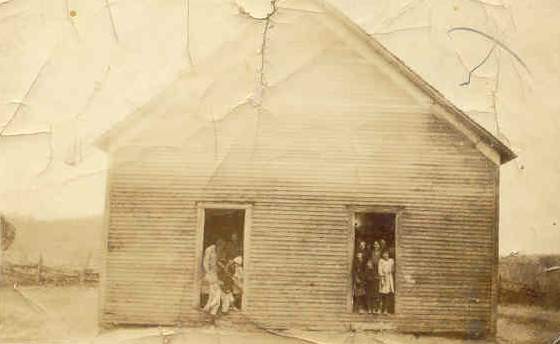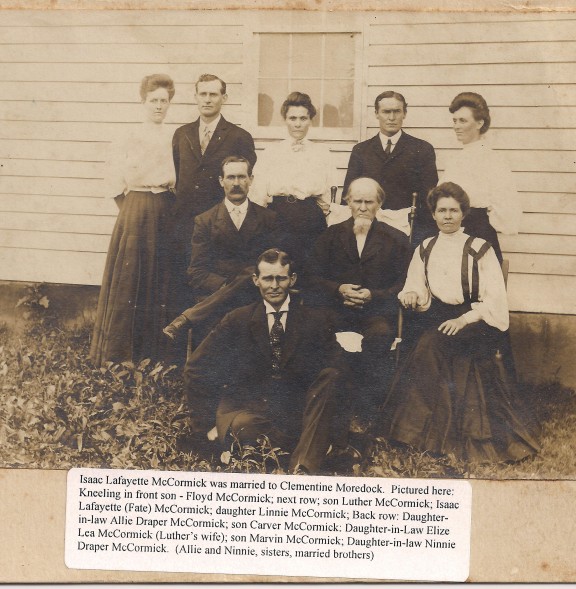Sunday, August 1, 2010 was Homecoming at the Bethlehem United Methodist Church located on Highway 84 just outside of Livingston going toward Monterey. The late Ms. Orpha Halsell, a long-time and faithful member, complied a history of the church from which I have taken some of the following information. Orpha’s book about Bethlehem indicates that more than 1200 acres of property in what is referred to as the Hartsaw Cove was once owned by the Gilbert Christian family. The land for the church was donated by the Christian family. The first structure was a small log building that stood just down the hill from the site of the present church building. The little log church also served the community as a subscription school. By researching the internet, I learned that subscription schools provided a way for the pioneers to educate their children, since there were no public monies available for education at that time. Some settlers, having strong religious beliefs, wanted to ensure their children were taught by the church. When there were enough pupils interested for the subscription school to be viable a teacher would be sought out. "Subscriptions" or tuition payments were expected for each pupil. Payment was also agreed upon, and could consist of money, as well as farm goods, farm stock, furs, fabric and any other item the parties could be obliged to barter.

A young lady by the name of Mary Katherine Sproul, who went by the name Miss Molly, taught in the log building at Bethlehem. A book entitled "A Civil War Diary" was written by Miss Molly, and after reading only a few pages of the diary, it is quite obvious she was an extremely well educated young woman, and one who was not afraid to stand up and voice her political beliefs during a time when that sort of thing was unheard of. Copies of that book can be purchased at the Overton County Heritage Museum. Here is some information from the Sproul book: Bailey Owen Bowden was the youngest of eight children whose parents were Elias Bowden and wife Mary (Owen) Bowden of Fentress County. Named for his grandfather, Bailey Owen Bowden was born in 1834 near Boatland. He worked on the farm with his father until he was twenty-two. At that age, he entered Mount Cumberland Academy which was located in Poplar Cove of Fentress County where he attended three sessions. He then enrolled in Hiwassee College, walking eighty-five miles to reach the school, and later taught Latin there. He had completed two years and six months at this college when the Civil War broke out. He enlisted in the Federal army and served until the close of the war, taking part in the battles of Nashville, Franklin, and others. Following the war, he became the first Clerk and Master of Fentress County, receiving the appointment in 1865. It is believed that when the Sproul family first came to Overton County, Mary Catherine, her parents and younger brother lived somewhere in the Hartsaw Cove or Copeland Cove area of Overton County. Miss Molly taught school at Bethlehem prior to the war in a little log building that was used as both school and church. Being an outspoken Union sympathizer in a county that favored the Confederates, life was difficult during the war years. Most families eventually withdrew their children from her school and she was forced to close it for lack of funds. In 1867, Bailey Owen Bowden, who also taught at Alpine Institute, married Mary Katherine Sproul. In the foreword of Mary Katherine's book a granddaughter, Helen Roberts-Gayden, wrote this about her grandmother on January 16, 1944, : "My grandmother, Mary Katherine Sproul, better known as Molly, was a small woman with beautiful red hair and blue eyes. She possessed something more for women in those days, a college education. Her brother, William Henry Harrison Sproul, sent her through school at The Female Institute in Maryville, Tennessee. She was known to be very spirited and independent. Her brothers (2), father and mother lived at Jonesville, Virginia, where she was born. Her father's name was James Sproul, her mother was a Barker before her marriage. She always boasted of belonging to the F.F.V.'s (first families of Virginia). While she was away at school, she had a very sad love affair. The young man to whom she was engaged was forced to marry another girl in order to clear her name. Broken hearted, Mary Katherine, along with her father, mother, and younger brother, John, moved to Livingston, Tennessee, in Overton County, where she was to open a school. It was while she was teaching there that the Civil War broke out. After the war, she married Bailey Owen Bowden. He also favored the Union and fought with the Federal Army, oddly enough against six brothers who were in the Confederate Army. He too completed a college education. Having so much in common contributed to a very happy marriage between Mary Katherine and Bailey Owen Bowden. She was 35 when she married, and at 36, gave birth to a little girl. Nora Deane Bowden, was to grow up and marry Albert Houston Roberts, who became a teacher, lawyer, and judge. Nora Deane was a brilliant child of brilliant parents and was also a talented pianist. Mary Katherine "Molly" Sproul Bowden was a very fine artist. Her house contained paintings in every available space. She destroyed these when she became old and her mind had failed. She was a very colorful and impressive character up through her last days."
Around 1900, Mary Katherine Sproul Bowden and Bailey Owen Bowden built the large white house still standing on the corner of East Main and Roberts Streets directly across from the sanctuary of First United Methodist Church. The house was originally built to face East Main Street, but since has been turned around to face Roberts Street. For a few years, the Bowden daughter, Nora Deane and husband, Albert Houston Roberts, lived in the home with her parents. At that time, Albert Houston Roberts was a practicing attorney in Livingston, and later in 1919, went on to become Governor of the State of Tennessee.
Both Bailey Owen Bowden and Mary Katherine Sproul Bowden are buried in Good Hope Cemetery in Livingston. A grandchild, Albert H. Roberts, Jr., is buried beside them.
Orpha Halsell’s information about Bethlehem states that a deed from A. Christian and A. Cullom was made to the following Trustees of the Bethlehem church: Jesse Allen, John H. Lea and I. L. (Issac Lafayette) McCormick, known as "Uncle Fate," my great-grandfather. When the new wooden structure was completed, the little log building was torn away. Then in 1918, this wooden building burned to the ground on the night following the burial of the wife of Jube Collins, who served as sheriff of Overton County at that time. Although no one knows for sure, the fire was believed to have been accidently started by some hunters who may have stopped in to warm themselves.

The Henard School had been built by this time, and the land on which it sat was donated by Issac Lafayette McCormick who, at that time, owned and lived on property that later became the Overton County Fairgrounds. The church held services in the Henard School until the new building could be completed. Orpha’s book indicates that rebuilding took about four years, a process that became a community affair. Louis Swafford gave lumber and logs to be used. Joe Terry hauled lumber from Jamestown. The bricks were hauled by wagon from Algood by Ernest (Bill Coon) Ledbetter, Hobson Dale, Bedford Halsell, (Orpha’s father), and others. The church was bricked by Bill Windle, father of Jerry Windle, one of the finest in his business. The building was finally completed in 1922 and is described as a twelve corner church. Mrs. Ellen Terry and Faye McCormick (who later became Mrs. Faye Cooper, (mother of the late Betty Cooper Dale) led the singing for awhile. Orpha’s history of the Bethlehem church also includes a list of former pastors who served up through the year 1976.

The cemetery at Bethlehem is quite historical. Among the graves is one for Private Sam Cullom, a black confederate soldier. According to an article found on the internet titled The Crossville Chronicle written by Pamela Woods and Barbara Parsons, Sam Cullom was a slave of the Cullom family of Overton County. He went to war with his owner's son, Jim Cullom. They were among the first unit to leave for Confederate duty from Overton County. They fought together in numerous campaigns until Jim Cullom was killed in the battles of the Atlanta campaign. Sam Cullom buried Jim and continued to fight with the unit until the end of the war, when he returned to Overton County. Sam Cullom’s application for a Tennessee Black Confederate pension was approved in three days of its arrival at the Confederate Pension Board in Nashville. Sam is buried in the Bethlehem cemetery just outside Livingston, in an area where Sam and his family were major landowners. Land in the area where the Overton County Fairgrounds sits once belonged to Sam Cullom, Black Confederate. There is also a family story that at one time Sam Cullom was threatened by a group of men and the KKK came to rescue him. Four granddaughters of Sam Cullom, three of whom live in the Livingston area, attended the historic grave marking held to honor his service to the Confederate States of America. The fourth granddaughter is a retired college professor, Dr. Althea Armstrong, who lives in Detroit, Michigan.
I’ve always felt a connection with the Bethlehem church because of my family’s involvement there. My great-grandfather, Issac Lafayette McCormick, and other members of his immediate family, my father, Marvin Chapin McCormick, my grandparents, Marvin and Ninnie (Draper) McCormick, my Aunt Rose McCormick are all buried there. My grandmother’s name, along with some other family members, is listed on some of the older membership rolls. One of my fondest memories is learning to drive by going around and around that church in Aunt Rose’s car. I wasn’t much more than 10 or 11 years old, and in looking back, I’m really amazed that Aunt Rose allowed me to do that. Evidently, she trusted me, because she didn’t say a word about my being too young to be behind the wheel of a car. My brother, Phil, mowed the cemetery at least one summer while we were growing up. Trimming around the tombstones was a job I helped out with, and lasted long enough to get a blister or two on my hands. That was long before weedeaters came along.
A walk through the cemetery is a good way to look back at the very interesting history that can be found at Bethlehem. There are many other graves of confederate soldiers, and another of those buried there is a son of Big Joe Copeland, one of the first settlers in Overton County. Homecoming, that includes dinner on the ground, is always held on the first Sunday in August. Visitors are more than welcome to attend and take part in a most enjoyable day.